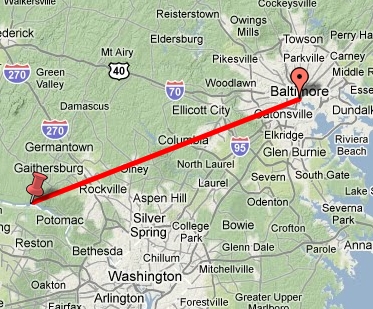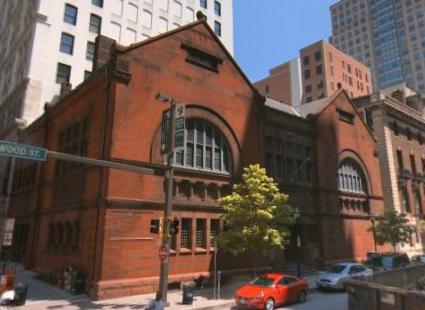Seneca Red Sandstone
A Native Maryland Building Stone
NOTE: If your device can not display the entire description, you can find the logging questions listed in the hint.
What is a building stone? Well, any type of dense, massive rock suitable for use in construction can be defined as a building stone.
This Earthcache is the first in a series of Earthcaches about Building Stones native to Maryland. Each one highlights a specific type of building stone, its origin, and an example of its use. Most of the quarry locations are closed and on private land nowadays, but you can still enjoy the unique properties of each by visiting a building, monument, or bridge constructed using them. I've done extensive research to identify with reasonable certainty the specific quarry that supplied the material for each of the places you will visit in this series.
Maryland has several distinct physio-graphic regions. Physio-graphic regions are broad-scale areas based on terrain texture, rock type, and geologic structure and history. In the US, they are generally broken down into three tiers: Divisions, Provinces, and Regions. Seneca Red Sandstone comes from the area known as the Upland Section of the Piedmont Plateau Province.

You are standing at the Southwest corner of a building that has extensive trim made of Seneca Red Sandstone (currently called “Poolesville Member of Manassas Sandstone” by geologists). The sandstone is of Late Triassic age, about 210 to 230 million years old, and was quarried along the Potomac River in Montgomery County Maryland. It is a sedimentary rock formed by small grains of quartz (silica) cemented together. Sandstones can usually be recognized by their “sandpaper feel.” The chief minerals in this rock are quartz, feldspar, and white mica. The red color is from iron oxide in the rock, mostly in the cementing material. Seneca Red Sandstone varies in color from a light reddish brown or cinnamon to a chocolate or deep-purple brown, depending on the composition and where exactly it was quarried.
|

Stone Source Location
|
Seneca Red sandstone is part of an extensive sandstone formation that extends from Connecticut all the way through Virginia and into the Carolinas. The formation enters Maryland from the North near Emmitsburg and extends almost due South all the way to where it crosses the Potomac River. The entire area in Maryland was once known as the “Red Lands” and can almost be drawn on a map using just the written geographical references to it that I found in old books and records during my research. For instance: “On the northwestern side of this county a broad belt of red sandstone hills runs down to the bed of the Potomac River. They begin a little east of Seneca Creek and extend to within a few rods of the mouth of the Monocacy River.”[1]
One of the biggest advantages of Seneca Red as a building stone is its workability when first quarried. It is soft enough to be cut and carved easily and it has a very uniform texture that allows very intricate designs to be chiseled. After some exposure time, it darkens and hardens and is ready to be used in construction. Another advantage this stone has for building is that is is very fine-grained, uniform, and compact, making it less susceptible to damage from freezing and not prone to scaling or flaking.
As with all good building stones, Seneca Red is strong and durable. With a specific gravity around 2.5 it weighs about 160 pounds per cubic foot. The Seneca Red sandstone that is used in this building has been shown to have a crush resistance of up to 18,000 psi (pounds per square inch). Compare that with modern concrete which has a strength of 7000 psi or less. Even high strength concrete with a strength of 14,500 psi is no match! There's a catch though. Sandstone must be laid flat with its natural grain or layering parallel to the load. If it is laid “on edge” it will deteriorate much more quickly.
The Building
Now known as the Redwood Trust, this dark red brick and sandstone building was constructed in 1885-1886 to serve as a bank and safe deposit. A beautiful example of the Romanesque Revival style, The Mercantile Trust & Deposit Company Building was one of the few in the area to survive the Great Baltimore Fire of 1904. It is considered one of the most significant works of architecture in downtown Baltimore. The bank played a major role in Baltimore becoming a dominant financial, commercial, and urban center. The building is listed on the National Register of Historic Places, was restored in 2001 at a cost of $1,800,000 and was awarded the Historic Preservation Award for excellence in 2002. Today, it houses the Chesapeake Shakespeare Company. An interesting feature are the “spy steps” you can see at various locations on the face of the building. They allowed police officers to step up and peer into the bank while on patrol. A brass ring at shoulder level was used to balance them on the step. A few of these are still in place.
|

The Building about 1890
|

The Building Today
|
The Quarry
The area west of Seneca Creek in Montgomery County has been the source of Seneca Red Sandstone since the 18th century. It was used in the construction of the Chesapeake and Ohio Canal, and the Smithsonian “Castle”. In fact, the C & O Canal then went on to be the major transportation route for stone out of the quarry. The Seneca Cutting Mill itself was made from Seneca Red, and the remains of the mill can still be seen just West of Seneca Creek where the canal widens to accommodate boats loading stone. By 1900, quarrying operations at the Seneca Quarry had stopped because the quality of the remaining stone was inferior. If you are ever nearby, check out the Seneca Creek Aqueduct of the C & O Canal. It is also made of Seneca Red.
|

Seneca Quarry in production
|

Seneca Quarry Today
|
To log this Earthcache:
Email me with the answers to the following questions. They can be found using the information above and by inspection of the building.
-
Look closely at the Sandstone trim pieces that are in horizontal rows up the side of the building. How do they differ in finish from the Sandstone blocks that make up the base of the building?
-
Do you see any evidence of weather damage to the stone base blocks? If so, describe it. Streaking or discoloration doesn't count.
-
Looking again at the trim pieces, can you see a grain or layering pattern? If so, what direction is it?
-
Looking even closer, what distinctly different colors of grains can you make out?
-
On the Southwest corner of the building, look at the southern face of the bottom corner block. What direction are the cracks in this stone? Keeping in mind the direction of the cracks in this block of stone, and the information given in the cache description above, why is this stone cracking?
-
Walk up the steps to the entrance of the building on the south side. Just outside the door to the left and right, you can see close up some of the intricate carving done to this stone when it was still relatively soft. What kind of animals are carved into the sandstone here?
-
Optional:Post a photo in your log of your favorite intricate carving work on the building, or your favorite view of the building with your GPSr in view. DO NOT post a photo of #6 above. That one is MY favorite, and you can't have it.
Logs containing spoiler pictures will be deleted without warning.
You may post your log at any time, but emailed answers must follow within 7 days or your log will be deleted.
Be sure and visit the other EarthCaches in this series:
 Almshouse Amphibole Schist
Almshouse Amphibole Schist
 Cockeysville Marble
Cockeysville Marble
 Woodstock Granite
Woodstock Granite
References:
[1] History of Western Maryland: being a history of Frederick, Philadelphia, 1882
Maryland Geological Survey, Volume 2, Baltimore, 1898
Architectural record, Volume 1. New York, 1891
Maryland Geological Survey (on-line)
Some images from Google Maps and Bing Maps